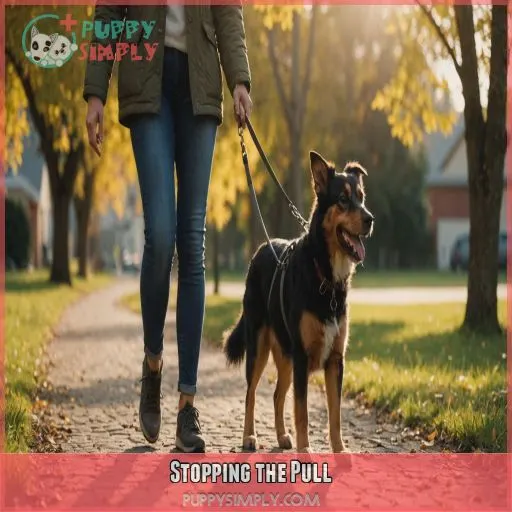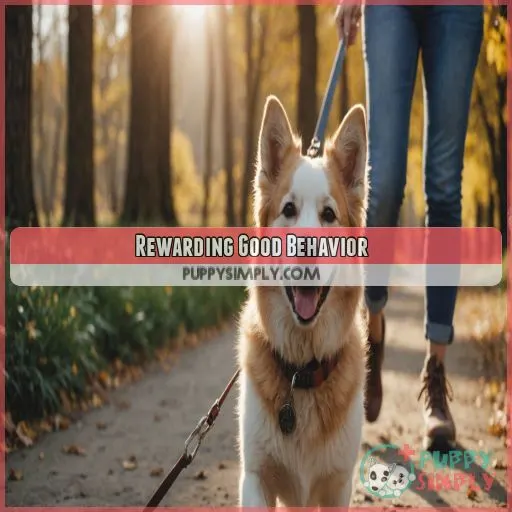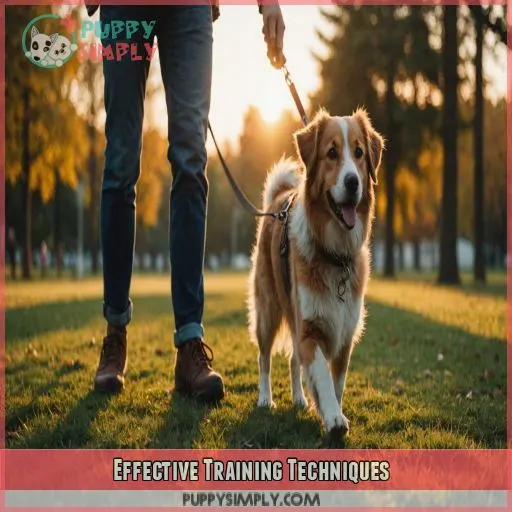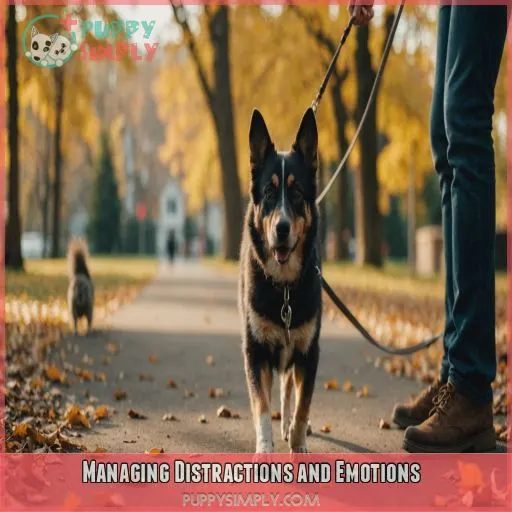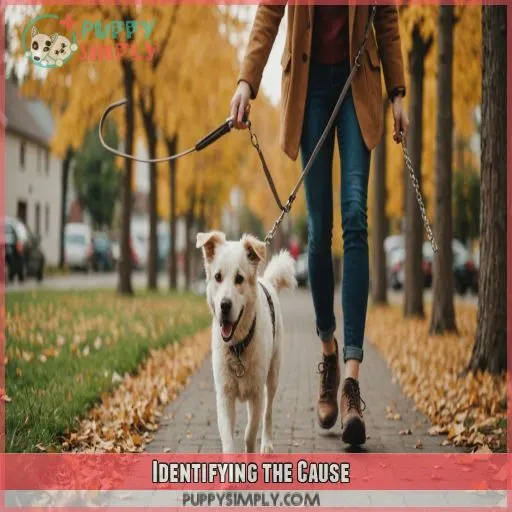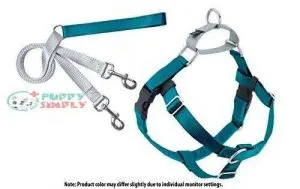This site is supported by our readers. We may earn a commission, at no cost to you, if you purchase through links.
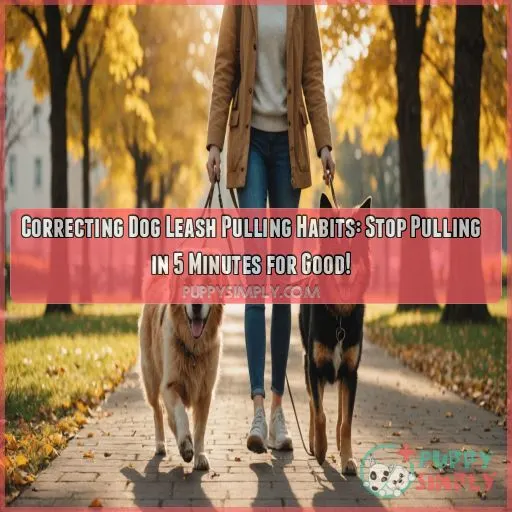
Don’t worry, with the right approach, you can break the pulling habit in just a few minutes a day. First, understand that your dog’s instincts and excess energy are likely driving this behavior.
Invest in a comfy no-pull harness and durable leash to set yourself up for success.
Reward good leash behavior consistently, using treats and praise to reinforce desired actions. By tapping into their natural motivations, you’ll be well on your way to a stress-free stroll – and that’s just the beginning!
Table Of Contents
- Key Takeaways
- Stopping the Pull
- Rewarding Good Behavior
- Effective Training Techniques
- Managing Distractions and Emotions
- Identifying the Cause
- Mastering Loose Leash Walking
- Choosing the Right Equipment
- Handling Challenging Behaviors
- Setting Your Dog Up for Success
- Quick Fixes and Long-term Results
- Frequently Asked Questions (FAQs)
- What is the #1 trick to stop your dog from pulling on the leash?
- How to correct dog pulling on leash?
- How to stop leash pulling in 5 minutes?
- How to train a dog to not pull on leash?
- Can puppies wear a no-pull harness while training ?
- How do I address leash pulling in an older dog ?
- Can leash pulling be a sign of underlying anxiety issues ?
- How long does it take to train a dog not to pull ?
- Can dog size affect the difficulty of leash training ?
- Conclusion
Key Takeaways
- Don’t let your furry friend walk all over you – literally! When they start pulling, stop moving forward. This simple yet effective technique helps them learn that pulling doesn’t get them where they want to go faster.
- It’s time to get a grip on the right gear! Invest in a comfy no-pull harness and a leash made from durable materials like nylon, rope, or leather. Your dog (and your arms) will thank you!
- Reward good behavior, and your dog will be walking on sunshine in no time! Use treats, praise, and life rewards to reinforce desired actions, and don’t forget to mix it up to keep things interesting.
- Remember, consistency is key when teaching your dog new tricks. Set a schedule, stick to it, and celebrate those small victories along the way. Before you know it, you’ll be strolling along like two peas in a pod!
Stopping the Pull
You’re not alone in the struggle to stop your dog from pulling on the leash – it’s a common issue that can be frustrating and even embarrassing. With the right approach and equipment, however, you can teach your dog to walk politely by your side and enjoy stress-free strolls together.
Why Dogs Pull on Leashes
Let’s face it – our furry friends can be quite the handful, especially when they’re pulling on the leash!
But why do they do it? Well, it’s because their canine instincts are taking over.
They might be triggered by environmental stimuli, or maybe they’re just bursting with excess energy.
Your behavior as an owner also plays a role. Think about it: are you unintentionally reinforcing their pulling habits?
One key thing to recognize is that physical exercise needs aren’t met by regular leash walks.
Invest in the Right Equipment
Let’s talk gear! Investing in the right equipment can be a total game-changer for stopping the pull. Think of it like hiking with the right boots – it makes all the difference!
Here are some must-haves to get you started:
- A comfy, no-pull harness that distributes the force across your dog’s chest and shoulders
- A leash made from durable materials like nylon, rope, or leather
- A plain, flat collar that fits snugly without constricting
- A head halter for extra control and gentle guidance
Rewarding Good Behavior
You’re on the right track to correcting your dog’s leash pulling habits, and now it’s time to focus on rewarding good behavior to make those habits stick. By consistently treating, praising, and rewarding your dog for walking nicely on a leash, you’ll be teaching them that good things come to those who walk politely by your side.
Always Reward Good Leash Behavior
As you master leash manners, remember to reward good behavior. It’s essential to acknowledge and reinforce desired actions. By doing so, you’re teaching your dog that walking by your side is the most rewarding experience. Reward timing is everything – the moment your dog displays good walking behavior, recognize and reward it.
Use Treats, Praise, and Life Rewards
Who says learning can’t be tasty? Reward your dog’s good leash behavior with treats, praise, and life rewards. Clicker training and positive reinforcement will be your new BFFs. Timing is everything – treat your dog the instant they walk by your side. Think of it as their paycheck for being a great walking buddy!
Be Consistent With Your Rewards
To correct dog leash pulling, be consistent with your rewards. Consistency is key to developing good habits. Here’s how to reward effectively:
- Reward immediately after good behavior
- Vary rewards to keep things interesting
- Use high-value treats for high-distraction areas
- Avoid over-rewarding to prevent over-expectation
- Make a reward schedule to stay on track
Effective Training Techniques
[ORIGINAL TEXT]
You’re probably keen to start tackling that pesky leash-pulling habit, and the good news is that with the right techniques, you can see improvements in just a few minutes a day! To kick-start your training, you should focus on a few key strategies that will help your dog learn to walk nicely by your side without pulling on the leash (Source).
Never Let Your Dog Walk When They Are Pulling
Don’t give in to those puppy dog eyes! When your pup pulls, stop moving forward. By doing so, you’re taking away the reward of pulling. This simple yet effective technique helps your furry friend learn that pulling doesn’t get them where they want to go.
Wait for a Loose Leash Before You Walk
When your dog starts pulling, stop moving forward. Wait for a loose leash before proceeding. This simple yet effective technique helps your dog understand that pulling doesn’t get them where they want to go faster.
- Avoid instant starts, they can trigger pulling.
- Leash pulling consequences include neck strain and injury.
- Loose leash benefits include a more enjoyable walk for both you and your dog.
- The impact of environment can contribute to leash pulling.
- Walking pace awareness helps prevent pulling caused by mismatched energy levels.
Incorporate Life Rewards on Your Walk
Now that you’re waiting for a loose leash, it’s time to make walks more engaging! Incorporate life rewards like sniffing, exploring, or playing fetch. This will keep your dog’s mind stimulated and make them associate calm behavior with fun experiences.
Walk at a Good Pace
Hey there, friend! When walking your dog, set a comfortable pace that works for both of you. Avoid speedy strolls that might encourage pulling. Instead, opt for a leisurely stride, keeping the leash relaxed, and your dog’s energy in check.
Managing Distractions and Emotions
[ORIGINAL TEXT]
As you work on breaking your dog’s leash pulling habit, you’ll encounter situations that can trigger pulling, such as other dogs, loud noises, or tempting smells. Learning how to manage these distractions and your own emotions will help you stay calm and patiently guide your dog in the direction of good leash behavior, making walks more enjoyable for both of you (Source).
[/ORIGINAL TEXT]
Keep Training Sessions Short and Fun
To keep training sessions short and fun, try these bite-sized tips:
- Break sessions into 10-minute chunks
- Use fun reward tactics like treats and praise
- Practice playful leash manners in different locations
- End sessions on a high note, before dog excitement wears off.
Be Interesting and Engaging on Walks
As you stroll with your dog, make it a blast! Incorporate walk games, variety, and mental stimulation to keep them engaged. Think hide-and-seek, sniffing adventures, or even simple obedience exercises. This interactive approach will keep your furry friend focused and delighted.
Stay Calm
When your dog gets distracted, take a deep breath and stay calm – they can sense your emotions! Composed leadership helps create a peaceful environment, reducing stress for both you and your furry friend. Practice calm walking tips for a serene stroll.
Engage Your Dog in Distracting Situations
Now that you’re calm, it’s time to engage your dog in distracting situations! Desensitize dog triggers by focusing their attention on you with treats and praise. Use dog distraction techniques like "watch me" to calm anxiety and overcome unwanted behaviors.
Identifying the Cause
You’re probably wondering why your dog is so determined to pull on the leash – is it boredom, excitement, or anxiety? To correct their leash pulling habits, you first need to identify the underlying cause of their behavior and understand what drives them to pull in the first place.
Why Do Dogs Pull on the Leash?
Let’s get to the root of the problem. Why do dogs pull on the leash? Here are 3 key insights:
- Canine Instincts: Dogs naturally chase and investigate their surroundings, making leash pulling a primal urge.
- Trigger Factors: Environmental triggers like other dogs, people, or smells can set them off.
- Leash Tension: The more tension, the more likely they’ll pull.
Boredom, Excitement, or Anxiety?
You’re wondering why your furry friend is pulling on the leash? It could be boredom, excitement, or anxiety! Look for canine stress signals like panting, yawning, or avoiding eye contact. Identify dog anxiety triggers like loud noises or strangers. Use boredom-busting strategies like sniffing games or excitement management techniques like calm, gentle praise.
Understanding Canine Behavior and Learning
To correct leash pulling, it’s essential to understand canine behavior and learning. Canines repeat actions with favorable results, so identify what drives your dog’s pulling. Is it boredom, excitement, or anxiety? Knowing the "why" helps you modify behavior. Focus on rewarding desired actions, like walking by your side, to reinforce good habits.
Mastering Loose Leash Walking
You’re about to break free from the tug-of-war with your furry friend – mastering loose leash walking is a game-changer for enjoyable strolls together. By teaching your dog to walk politely on a leash, you’ll transform those chaotic walks into relaxing experiences that strengthen your bond and make outings a breeze (Source).
What is Loose-leash Walking, and Does It Help?
Now that you’ve identified the cause of your dog’s leash pulling, it’s time to explore the benefits of loose-leash walking.
By definition, loose-leash walking means your dog is walking beside you without pulling on the leash, creating a relaxed and enjoyable experience for both of you.
This skill doesn’t require a perfect "heel" position, but rather a calm, slack leash.
Loose-leash training can make walks more enjoyable, and with patience and consistent practice, you can achieve this with your furry friend.
Exercise and Training for a Loose Leash
Now that you know the benefits of loose-leash walking, let’s get started with exercise and training.
Begin by physically and mentally stimulating your pup with fun activities, like agility training or scent games. This will help them focus on you during walks.
Use positive reinforcement training tools like treats, praise, and life rewards to encourage good behavior.
Choosing the Right Equipment
Choosing the right equipment is an essential step in correcting your dog’s leash pulling habits, and it all starts with a comfortable, no-pull adjustable dog harness. By investing in the right gear, you’ll be setting yourself and your furry friend up for success and making those daily walks a whole lot more enjoyable.
1. Comfortable No Pull Adjustable Dog Harness
- Harness Fitting Tips: Achieve a snug but not too tight fit
- No-Pull Benefits: Reduces pulling and tugging on the leash
- Dog Harness Types: Choose a harness with a padded lining
- Adjustable Harness Sizes: Select a harness with four adjustment points
- Canine Comfort Factors: Think about a harness with a reflective accent for visibility
Handling Challenging Behaviors
You’re making great progress with your dog’s leash training, but what happens when things get really tough? Let’s tackle those challenging behaviors like lunging and barking, and explore some prevention strategies and foundation skills to help you stay on track.
How Do I Handle Lunging and Barking?
Lunging and barking on walks? Don’t panic! First, acknowledge that your dog is overwhelmed. Identify the triggers – is it other dogs, loud noises, or strangers? Use calming techniques like deep breathing, treats, and praise to soothe them. For leash aggression help, consider consulting a professional to address underlying fears and develop a customized training plan.
Prevention: Foundation Skills
To prevent challenging behaviors like lunging and barking, focus on building solid foundation skills. Master basic obedience commands, practice positive reinforcement techniques, and prioritize canine socialization skills. Start with puppy leash training and invest in walking gear essentials. By laying the groundwork, you’ll set your dog up for success and reduce the likelihood of problematic behaviors.
What Should I Do if My Dog Pulls?
When your dog pulls, don’t panic! Stay calm and try these pro tips:
- Stop moving forward: Freeze in place to avoid rewarding the pulling behavior.
- Use an emergency stop method: Choose a specific word or action to signal your dog to stop pulling.
- Practice loose leash walking: Reward your dog for walking by your side without pulling.
Setting Your Dog Up for Success
You’re about to begin a journey to correct your dog’s leash pulling habits – congratulations! To set your dog up for success, you need to lay the groundwork by understanding why they pull, investing in the right equipment, and learning effective training techniques that make walks enjoyable for both of you.
How Do I Get Started?
You’re ready to tackle that pesky leash pulling habit! First, let’s set your dog up for success. Here’s a quick rundown to get you started:
| Step | Action | Why |
|---|---|---|
| 1 | Choose the right gear | A comfy harness and correct leash can make all the difference |
| 2 | Plan your route | Pick a quiet area with minimal distractions for training sessions |
| 3 | Set a schedule | Consistency is key when teaching your dog new habits |
| 4 | Reward good behavior | Treats and praise go a long way in reinforcing desired actions |
The
Now that you’re ready to start, it’s time to set your dog up for success!
Think of leash training as a journey, not a chore. Imagine the freedom and joy of strolling with your furry friend by your side, sans pulling.
To get there, commit to consistent training sessions, positive reinforcement, and patience. Reward good behavior, and don’t scold the not-so-good.
You’re building a partnership, after all. Follow these leash training tips, and you’ll be well on your way to a safer, happier dog-walking experience.
Quick Fixes and Long-term Results
You’re tired of being dragged around by your enthusiastic pup, and you want a quick fix to stop the leash pulling – like, yesterday! With a few simple tweaks and some consistent practice, you can teach your dog to walk nicely on a leash in just a few minutes a day.
How to Correct Dog Pulling on Leash?
To correct dog pulling on leash, start by addressing the root cause: boredom, excitement, or anxiety. Reward good behavior with treats, praise, and life rewards. Invest in the right equipment, like a no-pull harness, and practice loose-leash walking. Be consistent, patient, and calm – your furry friend will thank you!
How to Stop Leash Pulling in 5 Minutes?
Want to stop leash pulling in just 5 minutes? Try these quick fixes:
- When your dog starts pulling, stop moving forward. Wait for them to come back to your side before proceeding.
- Use verbal cues like "heel" or "walk" to remind them to stay by your side.
- Reward good behavior with treats and praise to reinforce desired habits.
Long-term Results With Consistency and Patience
quick fixes are great, but long-term results require consistency and patience. Think of training as a marathon, not a sprint. Set realistic training timeframes, celebrate small leash walking progress, and remember that patient owner tips make all the difference. Understand your dog’s temperament and stay committed to overcome consistency challenges.
Frequently Asked Questions (FAQs)
What is the #1 trick to stop your dog from pulling on the leash?
Ready for a game-changer? The #1 trick to stop your dog from pulling on the leash is to stop moving forward as soon as they start pulling ! It’s that simple – just freeze and wait for them to come back to you.
How to correct dog pulling on leash?
Leash pulling got you feeling like you’re in a tug-of-war? To correct dog pulling, reward good behavior, stop when they pull, and use life rewards like sniffing or greeting others to keep them engaged .
How to stop leash pulling in 5 minutes?
Want to stop leash pulling in 5 minutes? Try the ‘stop-start’ method: as soon as your dog pulls, stop moving. Wait for a loose leash, then reward and start walking again. Repeat this process to teach your dog to walk by your side.
How to train a dog to not pull on leash?
Ready to break free from the tug-of-war on your walks? Teaching your dog to walk on a loose leash takes patience, consistency, and positive reinforcement – let’s get started with rewarding good behavior and making walks more enjoyable!"
Can puppies wear a no-pull harness while training ?
When training your puppy, you can definitely use a no-pull harness to help them learn polite walking habits. Just see to it that it’s comfy and fitted correctly to prevent chafing or escaping.
How do I address leash pulling in an older dog ?
Did you know 80% of dogs pull on the leash due to excitement or anxiety? For older dogs, address leash pulling by reintroducing basic training, using positive reinforcement, and considering a no-pull harness for comfortable walks.
Can leash pulling be a sign of underlying anxiety issues ?
Yes, leash pulling can be a sign of underlying anxiety issues in dogs. If your dog is pulling due to anxiety or stress, address the root cause, and consider seeking professional help .
How long does it take to train a dog not to pull ?
The time it takes to train a dog not to pull on a leash can vary depending on several factors – it can take anywhere from a few weeks to several months with consistent training and rewards .
Can dog size affect the difficulty of leash training ?
In the context of leash training, your dog’s size can indeed impact the difficulty level. Smaller dogs might be more prone to pulling due to their high energy and big personalities, while larger dogs can accidentally knock you off balance.
Conclusion
Like a perfectly choreographed dance, you and your furry friend can glide through walks with ease.
Breaking the pulling habit may seem intimidating, but with the right approach, you can correct dog leash pulling habits in just a few minutes a day.
By investing in the right gear, rewarding good behavior, and using effective training techniques, you’ll be well on your way to a stress-free stroll.
Stay consistent, patient, and remember, every small step leads to a lifelong change.

